Whirlpool YWML55011HW, YWML55011HB, YWML55011HS, YWML75011HW, YWML75011HB Installation Instructions
...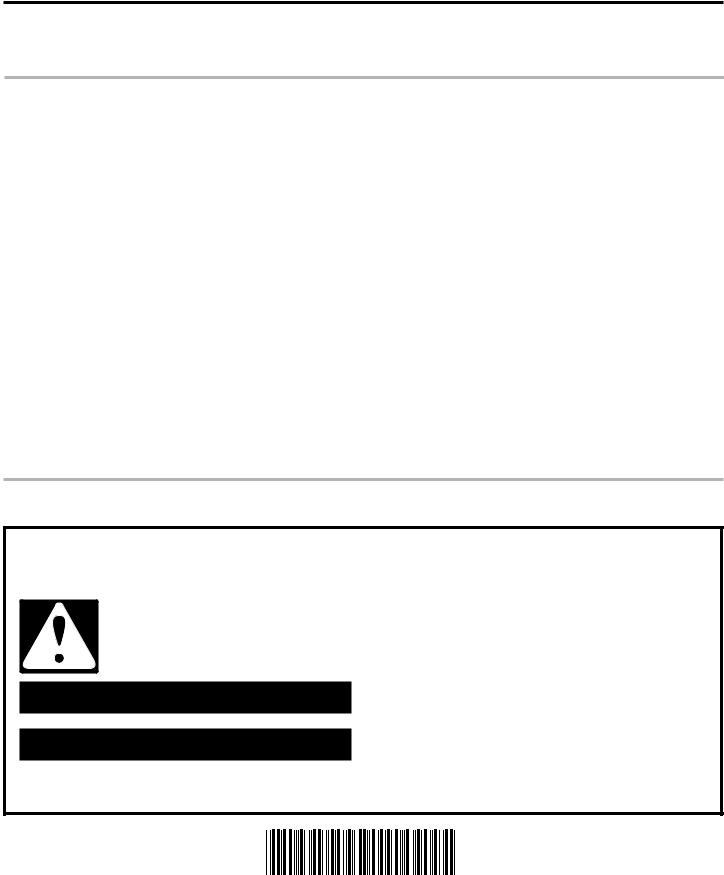
MICROWAVE HOOD COMBINATION INSTALLATION INSTRUCTIONS
This product is suitable for use above electric or gas cooking products up to and including 36" (91.4 cm) wide. See the “Installation Requirements” section for further notes.
These installation instructions cover different models. The appearance of your particular model may differ slightly from the illustration in these installation instructions.
Table of Contents |
|
MICROWAVE HOOD COMBINATION SAFETY............................ |
1 |
INSTALLATION REQUIREMENTS................................................. |
2 |
Tools and Parts............................................................................. |
2 |
Location Requirements................................................................. |
2 |
Product Dimensions..................................................................... |
3 |
Electrical Requirements .............................................................. |
3 |
INSTALLATION INSTRUCTIONS................................................... |
4 |
Wall Venting Installation Only....................................................... |
4 |
Install Damper Assembly (for wall venting only)........................... |
4 |
Roof Venting Installation Only....................................................... |
4 |
Install Damper Assembly (for roof venting only)........................... |
4 |
Vent Cover Installation.................................................................. |
5 |
Locate Wall Stud(s)....................................................................... |
5 |
Prepare Upper Cabinet................................................................. |
7 |
Mark Rear Wall.............................................................................. |
8 |
Drill Holes in Rear Wall.................................................................. |
9 |
Attach Mounting Plate to Wall...................................................... |
9 |
Install the Microwave Oven........................................................ |
10 |
Complete Installation.................................................................. |
11 |
VENTING DESIGN SPECIFICATIONS......................................... |
11 |
ASSISTANCE................................................................................. |
13 |
Replacement Parts..................................................................... |
13 |
Accessories................................................................................. |
13 |
MICROWAVE HOOD COMBINATION SAFETY
Your safety and the safety of others are very important.
many important safety messages in this manual and on your appliance. Always read and obey all safety
safety alert symbol.
alerts you to potential hazards that can kill or hurt you and others.
messages will follow the safety alert symbol and either the word “DANGER” or “WARNING.”
mean:
 DANGER
DANGER  WARNING
WARNING
You can be killed or seriously injured if you don't immediately follow instructions.
You can be killed or seriously injured if you don't follow instructions.
All safety messages will tell you what the potential hazard is, tell you how to reduce the chance of injury, and tell you what can happen if the instructions are not followed.
W11209522C
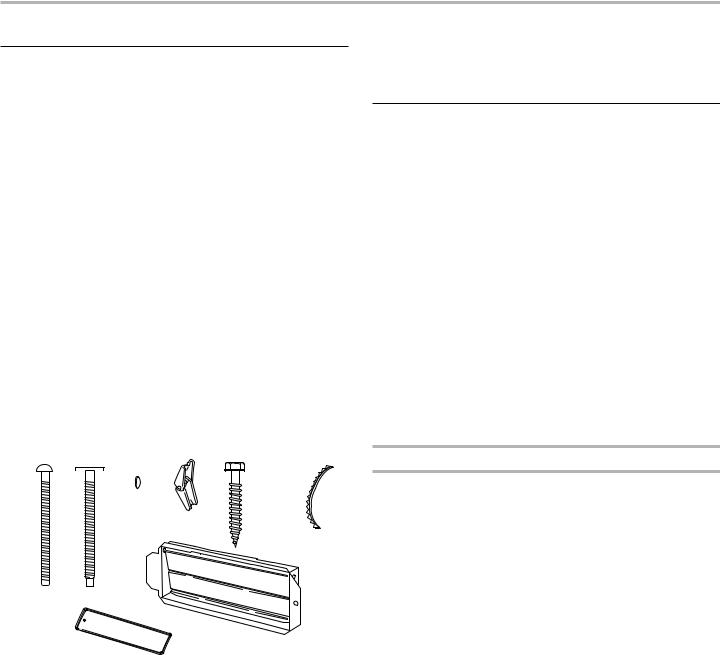
INSTALLATION REQUIREMENTS
Tools and Parts
Tools needed
Gather the required tools and parts before starting installation. Read and follow the instructions provided with any tools listed here.
■■ Measuring tape ■■ Pencil
■■ Masking tape or thumbtacks
■■ Scissors
■■ No. 3 Phillips screwdriver
|
for ¼- 20 x 3" bolts |
■■ |
Drill |
■■ |
3/16" (5 mm), 3/8" (10 mm), |
|
5/8" (16 mm) drill bits |
■■ |
3/4" (19 mm) hole saw |
■■ Diagonal wire cutting pliers
■■ Stud finder
■■ 7/16" socket wrench (or box wrench) for 1/4" x 2" lag screws
■■ 1½" (3.8 cm) diam. hole drill bit for wood or metal cabinet
■■ Keyhole saw
■■ Caulking gun and weatherproof caulking compound
■■ Duct tape
Parts supplied
For information on reordering, see the “Replacement Parts” section.
NOTE: The hardware items listed here are for wood studs. For other types of wall structures, be sure to use appropriate fasteners.
A  B
B C
C  D E
D E F
F  G
G
H
J
A.3/16-24 x 3" round-head bolts (2) B. 1/4-20 x 3" flat-head bolts (2) C. Washers (2)
D.3/16" toggle nuts (2)
E. 1/4" x 2" lag screws (2)
F.Sheet metal screws 5/32" x 5/16" (0.4 cm x 0.8 cm) (2)
G.Power supply cord bushing (1)
H.Damper assembly (for wall or roof venting)
J. Vent cover (2)
Not Shown:
■■ Mounting plate (Located on the upper polyfoam)
■■ Grease filters ■■ Charcoal filters
NOTE: Depending on model, grease filter and charcoal filter may be combined.
Materials Needed
Standard fittings for wall or roof venting. See the “Venting Design Specifications” section.
Location Requirements
IMPORTANT: Check the opening where the microwave oven will be installed. The location must provide:
■■ Minimum installation dimensions. See the “Installation Dimensions” illustration.
■■ Minimum one 2" x 4" (50.8 x 101.6 mm) wood wall stud and minimum 3/8" (10 mm) thickness drywall or plaster/lath within cabinet opening.
■■ Support for weight of 150 lbs (68 kg) which includes microwave oven and items placed inside the microwave oven and upper cabinet.
■■ Grounded electrical outlet inside upper cabinet. See the “Electrical Requirements” section.
NOTES:
■■ If installing the microwave oven near a left sidewall, make sure there is at least 6" (15.2 cm) of clearance between the wall and the microwave oven so that the door can open fully.
■■ Some cabinet and building materials are not designed to withstand the heat produced by the microwave oven for cooking. Check with your builder or cabinet supplier to make sure that the materials used will not discolor, delaminate, or sustain other damages.
Special Requirements
For Wall Venting Installation Only:
■■ Cutout must be free of any obstructions so that the vent fits properly and the damper blade opens freely and fully.
For Roof Venting Installation Only:
■■ If you are using a rectangular-to-round transition piece, the 3" (7.6 cm) clearance needs to exist above the microwave oven so that the damper blade can open freely and fully. See “Rectangular to Round Transition” illustration in the “Venting Design Specifications” section.
2
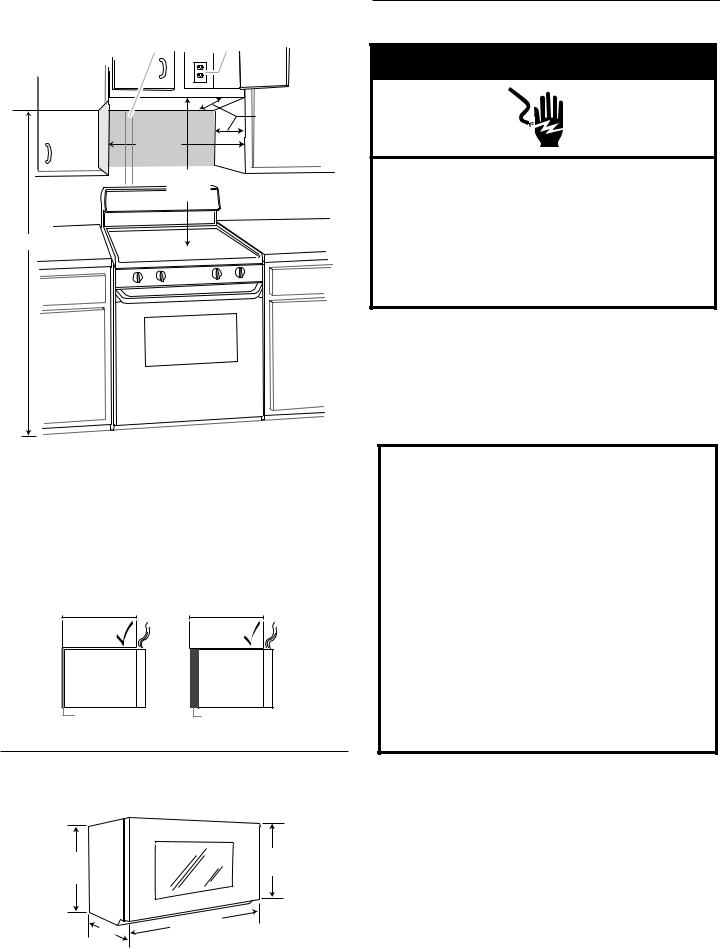
Installation Dimensions
NOTE: The grounded 3 prong outlet must be inside the upper cabinet. See the “Electrical Requirements” section.
A B
30" (76.2 cm) min.
24" (61 cm) typical*
60" ( 152.4 cm) min.
12" (30.5 cm) min.
14" (35.6 cm) max.
upper cabinet and side cabinet depth
A.2" x 4" wall stud
B.Grounded 3 prong outlet
*24” (61 cm) is typical for 60” (152.4 cm) installation height. Exact dimensions may vary depending on type of range/ cooktop below.
NOTE: To ensure good performance, do not obstruct top vent airflow. If cabinets are deeper than 14" (35.6 cm) but no more than 15" (38.1cm), use the bump out mounting kit replacing the mounting plate from the wall. The bump out mounting kit
(part # W11185746) is not provided but can be purchased from Whirlpool.
12" DEEPER
DEEPER 14" 14"
14" 14" DEEPER
DEEPER 15"
15"
mounting plate |
Bump out mounting |
|
|
|
bracket |
Product Dimensions
*Overall depth of product will vary slightly depending on door design.
10 / |
" |
|
|
10 |
/ " |
|
|
26.2cm |
|||
26.2cm |
|
|
|
||
|
|
|
|
|
|
|
|
|
|
) |
|
|
|
|
|
.0cm |
|
|
|
|
"(76 |
|
|
|
|
18" |
29⁄ |
|
|
|
|
45. |
|
|
|
|
|
5cm |
|
|
|
Electrical Requirements
 WARNING
WARNING
Electrical Shock Hazard Plug into a grounded 3 prong outlet. Do not remove ground prong.
Do not use an adapter.
Do not use an extension cord.
Failure to follow these instructions can result in death, fire, or electrical shock.
Observe all governing codes and ordinances.
Required:
■■ A 120 V, 60 Hz, AC only, 15 or 20 A electrical supply with a fuse or circuit breaker
Recommended:
■■ A time-delay fuse or time-delay circuit breaker
■■ A separate circuit serving only this microwave oven
GROUNDING INSTRUCTIONS
 For all cord connected appliances:
For all cord connected appliances:
The microwave oven must be grounded. In the event of an electrical short circuit, grounding reduces the risk of electric shock by providing an escape wire for the electric current. The microwave oven is equipped with a cord having a grounding wire with a grounding plug. The plug must be plugged into an outlet that is properly installed and grounded.
WARNING: Improper use of the grounding plug can result in a risk of electric shock. Consult a qualified electrician or serviceman if the grounding instructions are not completely understood, or if doubt exists as to whether the microwave oven is properly grounded.
Do not use an extension cord. If the power supply cord is too short, have a qualified electrician or serviceman install an outlet near the microwave oven.
SAVETHESE INSTRUCTIONS
3
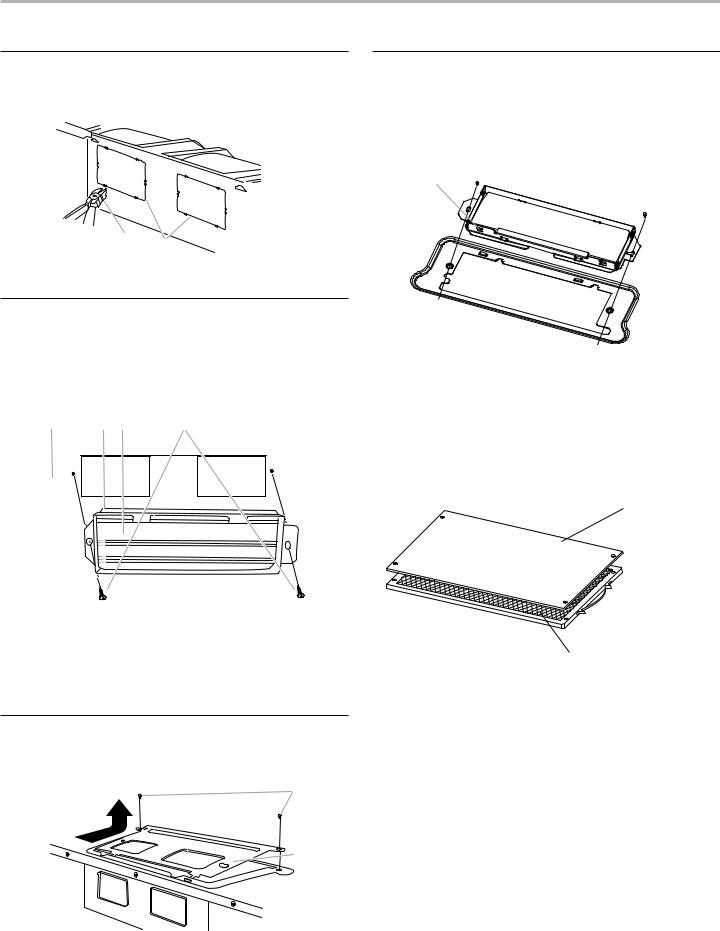
INSTALLATION INSTRUCTIONS
WallVenting Installation Only
1. Using diagonal wire cutting pliers, gently snip out the rectangular vent cover on the damper plate.
A
B
A.Diagonal wire cutting pliers
B.Damper vent covers
Install Damper Assembly
(for wall venting only)
1.Check that damper blade moves freely, and opens fully.
2.Position the damper assembly on the back of the microwave oven so that the damper blade hinge is at the top, and the damper blade opens away from the microwave oven.
A B C D
A.Back of microwave oven
B.Damper assembly
C.Damper blade
D.Sheet metal screw 5/32" x 5/16" (0.4 cm x 0.8 cm)
3.Secure damper assembly with 2 Sheet metal screws 5/32" x 5/16" (0.4 cm x 0.8 cm).
RoofVenting Installation Only
1.Remove screws attaching damper plate to top of microwave oven exterior. Slide damper plate toward the front of the microwave oven and lift up.
A
Install Damper Assembly
(for roof venting only)
1.Check that damper blade moves freely, and opens fully.
2.Position the damper assembly on the top of microwave oven so that the damper blade hinge is at the top, and the damper blade opens away from the microwave oven.
B  A
A
 C
C
 D
D
A.Screws
B.Damper assembly
CDamper blade
DTop of the microwave oven
3.Secure damper assembly with 2 Sheet metal screws 5/32" x 5/16" (0.4 cm x 0.8 cm).
Note: To ensure good performance of airflow, for Wall and Roof venting, remove the charcoal filter from the bottom plate before operating the microwave oven.
Charcoal filter
Grease filter
B
A.Screws
B.Damper plate
4

Vent Cover Installation
(for both upper vent and wall vent installation)
1.Remove screws attaching vent cover B, C and D to top of microwave exterior. Slide out vent covers B, C and D. Keep the vent cover C for step 2 use.
A
B
C D 

 E
E
A.Screws
B.Vent Cover
C.Vent Cover
D.Vent Cover
E.Top front of the microwave
NOTE: Keep the vent cover B and vent cover D for recirculation in future.
2.Place the vent cover C (removed from step 1) to the first position to the left and rotate it 180 degrees.
C

3.Remove the vent covers located in the upper polyfoam (see item J in "Parts Supplied" section).
4.Attach the vent covers to vents B & C using the screws removed in step 1.
A
B
C 
 E
E
A. Screw
B. Vent cover (located in upper polyfoam)
C. Vent cover (located in upper polyfoam)
E. Top front of the microwave
Locate Wall Stud(s)
NOTE: If no wall studs exist within the cabinet opening, do not install the microwave oven.
See illustrations in “Possible Wall Stud Configurations.”
1.Using a stud finder, locate the edges of the wall stud(s) within the opening.
2.Mark the center of each stud and draw a plumb line down each stud center. See illustrations in “Possible Wall Stud Configurations.”
5
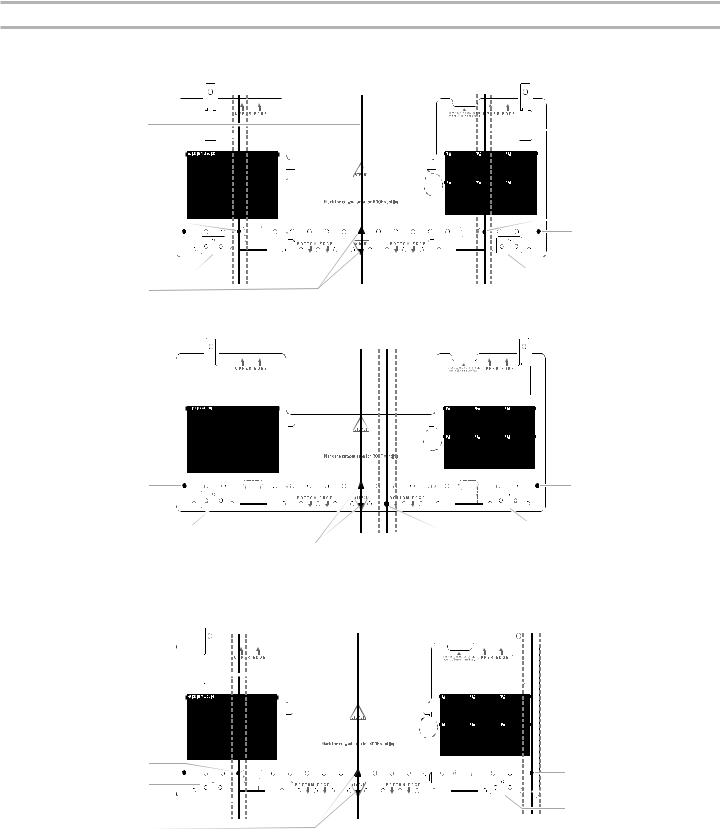
Possible Wall Stud Configurations
These depictions show examples of preferred installation configurations with the mounting plate.
No Wall Studs at End Holes
Figure 1
C
C
No Wall Studs at End Holes
Figure 2
B  C
C
A
NOTE: If wall studs is within 6" (15.2 cm) of the vertical centerline (see "Mark Rear Wall" section), only recirculation or roof venting installation can be done.
Wall Studs at End Holes
Figure 3
B
A,D
C
C
A.End holes (on mounting plate)
B.Cabinet opening vertical centerline
C.Wall stud centerlines
D.Holes for lag screws
E.Support tabs
F.Mounting plate center markers
6
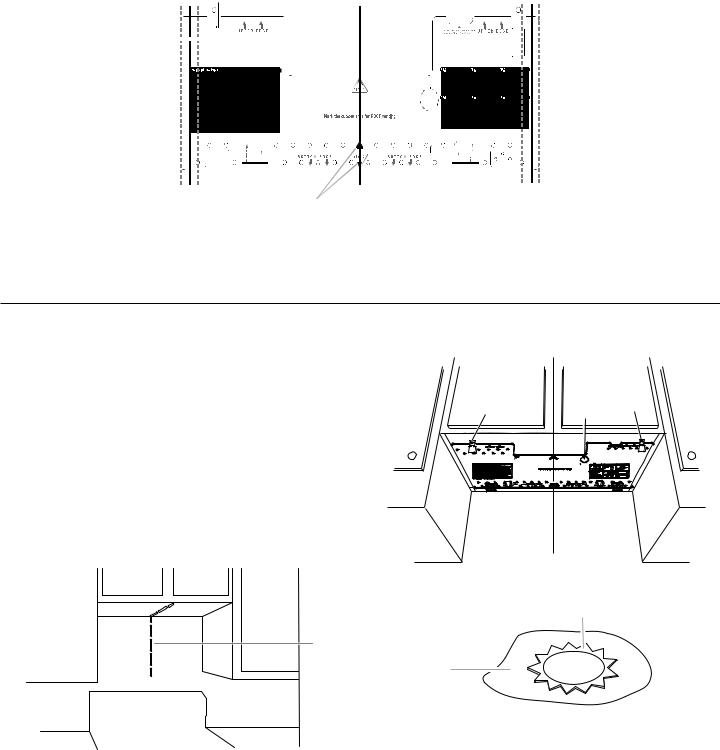
Wall Studs at End Holes
Figure 4
B
A,D
E 



C 
F
A.End holes (on mounting plate)
B.Cabinet opening vertical centerline
C.Wall stud centerlines
D.Holes for lag screws
E.Support tabs
F.Mounting plate center markers
 A,D
A,D
 C
C
 E
E
Prepare Upper Cabinet
You can find the quick reference guide direct from the mounting plate marking, or use this installation guide for installation.
See below install steps:
1.Disconnect power to outlet.
2.Remove all contents from upper cabinet.
3.Mark centerline on bottom of upper cabinet. Place mounting plate against the bottom of the upper cabinet. Make sure the mounting plate centerline aligns with the vertical centerline on the rear wall.
The “Rear wall” arrows must be against the rear wall so that the holes cut into the upper cabinet align with the holes in the top of the microwave oven.
Note: If the wall behind the microwave oven (as installed) has a partial wall covering (for example, tile backslash), be sure the “Rear Wall” arrows align to the thickest part of the rear wall (for example, the thickness of the tiles rather than the drywall).
A
A.Centerline
4.Make sure the 10 3/4"(27.3 cm) dimension from the rear wall to points “D” and “E” on the template is maintained.
5.Place mounting plate against the bottom of upper cabinet line and mark power supplier hole, cut the 1¹⁄2" (3.8 cm) diameter hole at the circular shaded area “G” on the template. This hole is for the power supply cord.
D 

 G E
G E
t
Note: If upper cabinet is metal, the supply cord bushing needs to be installed around the supply cord hole as shown.
B
A
A.Metal cabinet
B.Power supply cord bushing
6.Drill 3/8" (10 mm) holes at points “D” and “E” on the template. These are for two 1⁄4-20 x 3" bolts and washers used to secure the microwave oven to the upper cabinet.
Note: If replacing a range hood that has the direct wire power supply coming from the wall, install outlet box accessory kit in upper cabinet. The Outlet Box Kit (part #W11082816) is not provided but can be purchased from Whirlpool.
7
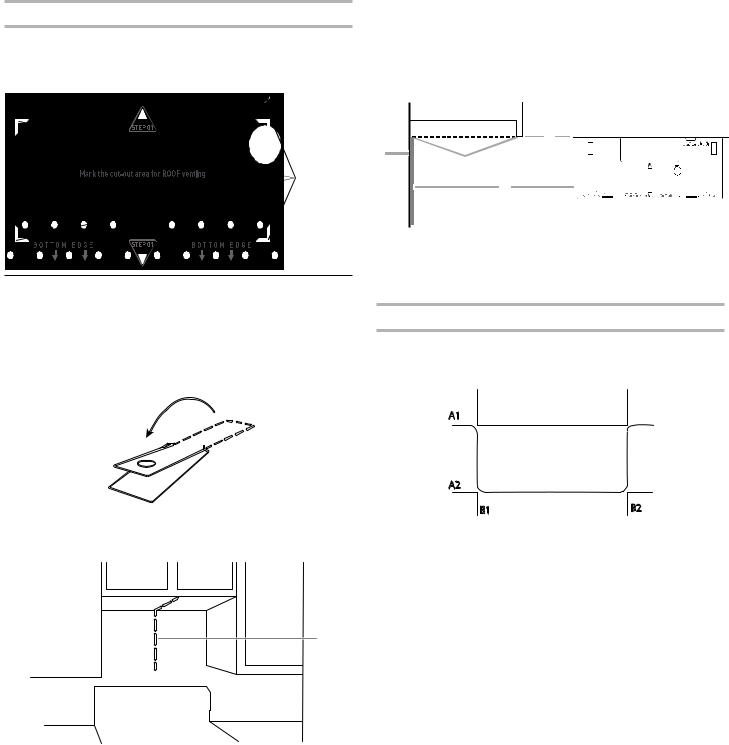
Roof Venting Installation Only
7.If venting through the roof, mark and trace the corner punches on the mounting plate. Set mounting plate aside, cut the venting area out from the bottom of the upper cabinet using a keyhole saw.
4 Corners
Mark Rear Wall
The microwave oven must be installed on a minimum of 1 wall stud, preferably 2, using a minimum of 1 lag screw, preferably 2.
1.Fold 2 mounting tabs forward into the tab cutout. Note that the tabs will NOT be flush after folding.
Fold Forward
2.Mark centerline on the back wall. Place mounting template against the back wall, find and clearly mark the vertical centerline of the opening.
A
A. Centerline
3.Align the center markers on the mounting plate to the centerline of the wall. Make sure it is leveled and top of the mounting plate is butted up against the bottom edge of the upper cabinet.
NOTE: If the front edge of the upper cabinet is lower than the back edge, lower the mounting plate so that its top is leveled with the front edge of the cabinet.
D
A
C
B









A.Rear wall
B.Mounting Template
C.Top of mounting template must
align with front edge of cabinet D. Front edge of upper cabinet
Wall Venting Installation Only
4.If venting through the wall, place mounting plate on the wall and mark the cut-out area. Set mounting plate aside, then using a keyhole saw, cut out hole in the wall at back venting area.
A1
Cut-out area for
BACK WALL Venting
A2
B1 |
B2 |
8
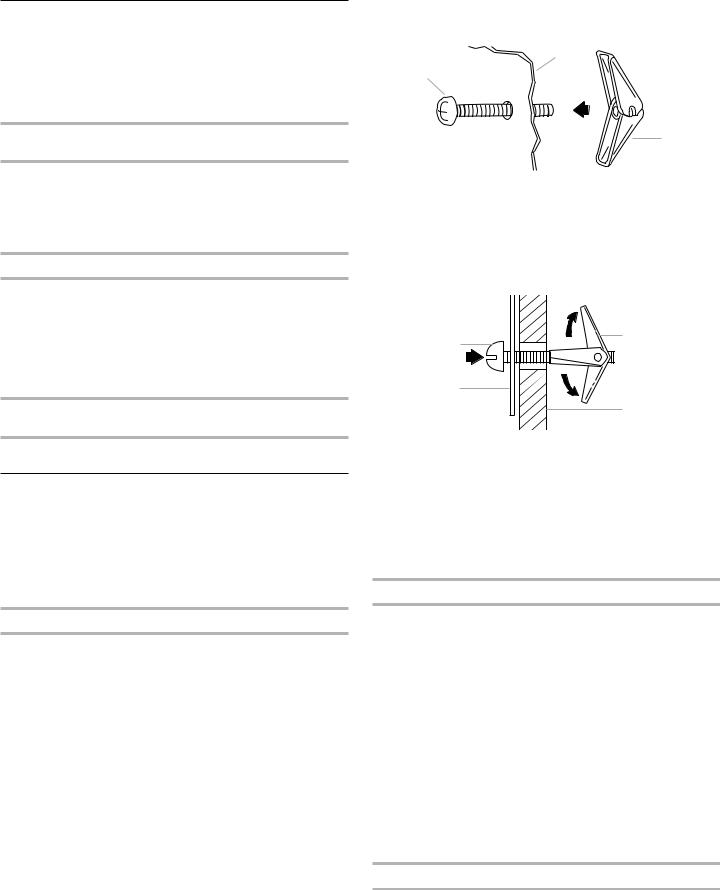
Drill Holes in Rear Wall
In addition to being installed on at least 1 wall stud, the mounting plate must attach to the wall at both end holes. If the end holes are not over wall studs, use two 3/16-24 x 3” round head bolts with toggle nuts; if 1 end hole is over a wall stud, use 1 lag screw and one 3/16-24 x 3” round-head bolt with toggle nut; or if both end holes are over wall studs, use 2 lag screws. Following are 3 installation configurations.
Installation for No Wall Studs at End Holes (Figures 1 and 2)
1.Drill 5/8” (16 mm) holes through the wall at both end holes marked in Step 3 of “Mark Rear Wall.”
2.Drill 3/16” (5 mm) hole(s) into the wall stud(s) at the hole(s) marked in Step 6 of “Mark Rear Wall.” Refer to figures 1 and 2 in “Possible Wall Stud Configurations” in the “Locate Wall Stud(s)” section.
Installation for Wall Stud at One End Hole (Figure 3)
1.Drill a 3/16” (5 mm) hole into the wall stud at the end hole marked in Step 3 of “Mark Rear Wall.”
2.If installing on a second wall stud, drill a 3/16” (5 mm) hole into the wall stud at the other hole marked in Step 6 of “Mark Rear Wall.” Refer to Figure 3 in “Possible Wall Stud Configurations” in the “Locate Wall Stud(s)” section.
3.Drill a 5/8” (16 mm) hole through the wall at the other end hole.
Installation for Wall Studs at Both End Holes (Figure 4)
1.Drill 3/16” (5 mm) hole into the wall stud at the end hole marked in Step 3 of “Mark Rear Wall.
Attach Mounting Plate to Wall
NOTE: Secure the mounting plate to the wall at both end holes drilled into the wall studs and/or drywall using either 3/16-24 x 3" round-head bolts and toggle nuts or 1/4" x 2" lag screws.
Refer to illustrations in “Possible Wall Stud Configurations” in the “Locate Wall Stud(s)” section.
For fast wall and roof vent installation, see the quick reference guide on the mounting plate.
No Wall Studs at End Holes (Figures 1 and 2)
NOTE: The mounting plate must be secured to the wall on at least 1 wall stud as well as at both ends.
1.With the support tabs of the mounting plate facing forward, insert 3/16-24 x 3" round-head bolts through both end holes of mounting plate.
2.Start toggle nuts on bolts from the back of the mounting plate. Leave enough space for the toggle nuts to go through the wall and to open.
B
A
C
A. 3/16-24 x 3" round-head bolt
B.Mounting plate
C.Spring toggle nut
3.Position mounting plate on the wall.
4.Push the 2 bolts with toggle nuts through the drywall and finger tighten the bolts to make sure toggle nuts have opened against drywall.
A |
C |
|
|
B |
|
|
D |
A. 3/16-24 x 3" round-head bolt
B.Mounting plate
C.Spring toggle nut
D.Drywall
5.Insert lag screw(s) into the hole(s) drilled into wall stud(s) in Step 2 of “Installation for No Wall Studs at End Holes” in the “Drill Holes in Rear Wall” section.
6.Check alignment of mounting plate, making sure it is level.
7.Securely tighten all lag screws and bolts.
Wall Stud at One End Hole (Figure 3)
1.With the support tabs of the mounting plate facing forward, insert a 3/16-24 x 3" round-head bolt through the end hole that fits over the 5/8" (16 mm) hole drilled in Step 3 of “Installation for Wall Stud at One End Hole” in the “Drill Holes in Rear Wall” section.
2.Start a toggle nut on the bolt from the back of the mounting plate. Leave enough space for the toggle nut to go through the wall and to open.
3.Position mounting plate on the wall.
4.Push the bolt with toggle nut through the drywall and finger tighten the bolt to make sure toggle nut has opened against drywall.
5.Insert a lag screw into the remaining end hole.
6.If installing on a second wall stud, insert a lag screw into the other hole drilled in Step 2 of “Installation for Wall Stud at One End Hole” in the “Drill Holes in Rear Wall” section. Check alignment of mounting plate, making sure it is level.
7.Securely tighten the lag screw(s) and bolt.
Wall Studs at Both End Holes (Figure 4)
1.Position mounting plate on the wall.
2.Insert lag screws into both end holes.
3.Check alignment of mounting plate, making sure it is level.
4.Securely tighten the lag screws.
9
